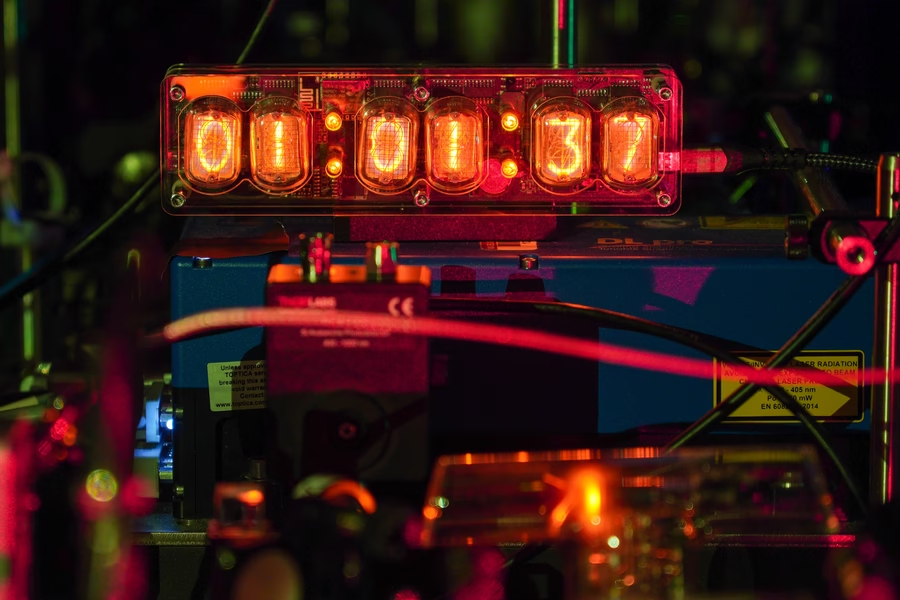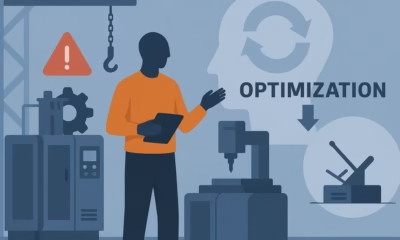Space & Physics
Is Time Travel Possible? Exploring the Science Behind the Concept
Subtle forms of time travel — such as time dilation — do occur and have practical implications in science and technology.

Everyone is, in a way, a time traveller. Whether we like it or not, we are constantly moving through time — one second per second. From one birthday to the next, we travel through time at a steady pace, just like walking one foot per footstep. However, when we talk about “time travel,” we often imagine something much more dramatic — traveling faster (or even backward) through time, as seen in science fiction movies and novels. But is such a thing truly possible?
From Fiction to Science
The concept of time travel first gained widespread attention through literature, particularly with H.G. Wells’ 1895 novel The Time Machine. In it, time is described as the fourth dimension, akin to space, and the protagonist travels forward and backward in time using a specially built machine. Interestingly, this idea predates Albert Einstein’s theory of relativity, which would later reshape how we understand space and time.

Einstein’s Contribution: Relativity and Time Dilation
In the early 20th century, Albert Einstein introduced a revolutionary idea through his theory of relativity. He proposed that space and time are interconnected, forming a four-dimensional continuum called space-time. According to his theory, the speed of light (186,000 miles per second) is the ultimate speed limit in the universe. But how does this relate to time travel?
Einstein’s theory states that as you move faster — especially at speeds approaching the speed of light — time slows down relative to someone who is stationary. This phenomenon, known as time dilation, has been proven through various experiments. One famous example involved two synchronized atomic clocks — one placed on Earth and the other onboard a high-speed jet. When the plane returned, the onboard clock showed slightly less time had passed compared to the one on the ground. This demonstrates that, at very high speeds, time passes more slowly.
Astronaut Twins and Time
A notable example of time dilation involved twin astronauts Scott and Mark Kelly. Scott spent 520 days aboard the International Space Station, while Mark spent only 54 days in space. Due to the effects of time dilation, Scott aged slightly less than Mark — by about 5 milliseconds. Though this difference is minuscule, it is real and measurable, showing that time can indeed “bend” under certain conditions.
The GPS Example
Surprisingly, even GPS satellites experience time differently than we do on Earth. These satellites orbit at altitudes of about 20,200 kilometers and travel at speeds of roughly 14,000 km/h. Due to both their speed (special relativity) and weaker gravitational pull at high altitudes (general relativity), time ticks slightly faster for the satellites than for devices on Earth. This discrepancy is corrected using Einstein’s equations to ensure precise positioning. Without these adjustments, GPS systems could be off by several miles each day.
Science Fiction vs. Scientific Reality
Science fiction has long explored imaginative time travel — characters jumping into machines and traveling decades into the future or past. Stories often depict them altering historical events or witnessing the far future. However, there is no scientific evidence that anyone has travelled backward or forward in time in such a dramatic way.
Renowned physicist Stephen Hawking addressed this idea humorously in 2009. He hosted a party for time travellers — but only announced it afterward, reasoning that if time travel were possible, people from the future would show up. No one came. Hawking took this as a tongue-in-cheek sign that backward time travel may not be feasible.
Could Wormholes Be the Key?
Theoretical physics does suggest possibilities like wormholes — shortcuts through space-time. According to Einstein’s equations, these could, in theory, connect distant places and times. A wormhole might allow someone to enter at one point in space and exit at another, potentially in a different time. However, this remains purely speculative. The extreme gravitational forces within black holes or wormholes could destroy anything attempting to pass through.
Moreover, the idea of backward time travel introduces major paradoxes — such as the classic “grandfather paradox,” where someone goes back in time and prevents their own existence. Such contradictions challenge our understanding of causality and logic.
The Limitations of Current Science
At present, building a time machine capable of transporting people backward or forward in time by centuries remains outside the realm of scientific possibility. It’s a concept best enjoyed in novels and films for now. However, subtle forms of time travel — such as time dilation — do occur and have practical implications in science and technology.
While we may not have DeLoreans or TARDISes at our disposal, time travel — at least in small, measurable ways — is a part of our reality. The interplay of speed, gravity, and time demonstrates that our universe is far more flexible than it appears. And who knows? In some distant corner of the cosmos, nature might already be bending time in ways we are only beginning to imagine.
Until then, we’ll keep moving forward — one second per second.
Space & Physics
MIT Pioneers Real-Time Observation of Unconventional Superconductivity in Magic-Angle Graphene
Physicists have directly observed unconventional superconductivity in magic-angle twisted tri-layer graphene using a new experimental platform, revealing a unique pairing mechanism

MIT physicists have unveiled compelling direct evidence for unconventional superconductivity in “magic-angle” twisted tri-layer graphene—an atomically engineered material that could reimagine the future of energy transport and quantum technologies. Their new experiment marks a pivotal step forward, offering a fresh perspective on how electrons synchronize in precisely stacked two-dimensional materials, potentially laying the groundwork for next-generation superconductors that function well above current temperature limits.
Instead of looking merely at theoretical possibilities, the MIT team built a novel platform that lets researchers visualize the superconducting gap “as it emerges in real-time within 2D materials,” said co-lead author Shuwen Sun in a media statement. This gap is crucial, reflecting how robust the material’s superconducting state is during temperature changes—a key indicator for practical applications.
What’s striking, said Jeong Min Park, study co-lead author, is that the superconducting gap in magic-angle graphene differs starkly from the smooth, uniform profile seen in conventional superconductors. “We observed a V-shaped gap that reveals an entirely new pairing mechanism—possibly driven by the electrons themselves, rather than crystal vibrations,” Park said. Such direct measurement is a “first” for the field, giving scientists a more refined tool for identifying and understanding unconventional superconductivity.
Senior author Pablo Jarillo-Herrero emphasized that their method could help crack the code behind room-temperature superconductors: “This breakthrough may trigger deeper insights not just for graphene, but for the entire class of twistronic materials. Imagine grids and quantum computers that operate with zero energy loss—this is the holy grail we’re moving toward,” Jarillo-Herrero said in the MIT release.
Collaborators included scientists from Japan’s National Institute for Materials Science, broadening the impact of the research. The discovery builds on years of progress since the first magic-angle graphene experiments in 2018, opening what many now call the “twistronics” era—a field driven by stacking and twisting atom-thin materials to unlock uniquely quantum properties.
Looking ahead, the team plans to expand its analysis to other ultra-thin structures, hoping to map out electronic behavior not only for superconductors, but for a wider range of correlated quantum phases. “We can now directly observe electron pairs compete and coexist with other quantum states—this could allow us to design new materials from the ground up,” said Park in her public statement.
The research underscores the value of visualization in fundamental physics, suggesting that direct observation may be the missing link to controlling quantum phenomena for efficient, room-temperature technology.
Space & Physics
Atoms Speak Out: Physicists Use Electrons as Messengers to Unlock Secrets of the Nucleus
Physicists at MIT have devised a table-top method to peer inside an atom’s nucleus using the atom’s own electrons

Physicists at MIT have developed a pioneering method to look inside an atom’s nucleus — using the atom’s own electrons as tiny messengers within molecules rather than massive particle accelerators.
In a study published in science, the researchers demonstrated this approach using molecules of radium monofluoride, which pair a radioactive radium atom with a fluoride atom. The molecules act like miniature laboratories where electrons naturally experience extremely strong electric fields. Under these conditions, some electrons briefly penetrate the radium nucleus, interacting directly with protons and neutrons inside. This rare intrusion leaves behind a measurable energy shift, allowing scientists to infer details about the nucleus’ internal structure.
The team observed that these energy shifts, though minute — about one millionth of the energy of a laser photon — provide unambiguous evidence of interactions occurring inside the nucleus rather than outside it. “We now have proof that we can sample inside the nucleus,” said Ronald Fernando Garcia Ruiz, the Thomas A. Franck Associate Professor of Physics at MIT, in a statement. “It’s like being able to measure a battery’s electric field. People can measure its field outside, but to measure inside the battery is far more challenging. And that’s what we can do now.”
Traditionally, exploring nuclear interiors required kilometer-long particle accelerators to smash high-speed beams of electrons into targets. The MIT technique, by contrast, achieves similar insight with a table-top molecular setup. It makes use of the molecule’s natural electric environment to magnify these subtle interactions.
The radium nucleus, unlike most which are spherical, has an asymmetric “pear” shape that makes it a powerful system for studying violations of fundamental physical symmetries — phenomena that could help explain why the universe contains far more matter than antimatter. “The radium nucleus is predicted to be an amplifier of this symmetry breaking, because its nucleus is asymmetric in charge and mass, which is quite unusual,” Garcia Ruiz explained.
To conduct their experiments, the researchers produced radium monofluoride molecules at CERN’s Collinear Resonance Ionization Spectroscopy (CRIS) facility, trapped and cooled them in laser-guided chambers, and then measured laser-induced energy transitions with extreme precision. The work involved MIT physicists Shane Wilkins, Silviu-Marian Udrescu, and Alex Brinson, alongside international collaborators.
“Radium is naturally radioactive, with a short lifetime, and we can currently only produce radium monofluoride molecules in tiny quantities,” said Wilkins. “We therefore need incredibly sensitive techniques to be able to measure them.”
As Udrescu added, “When you put this radioactive atom inside of a molecule, the internal electric field that its electrons experience is orders of magnitude larger compared to the fields we can produce and apply in a lab. In a way, the molecule acts like a giant particle collider and gives us a better chance to probe the radium’s nucleus.”
Going forward, the MIT team aims to cool and align these molecules so that the orientation of their pear-shaped nuclei can be controlled for even more detailed mapping. “Radium-containing molecules are predicted to be exceptionally sensitive systems in which to search for violations of the fundamental symmetries of nature,” Garcia Ruiz said. “We now have a way to carry out that search”
Space & Physics
Physicists Double Precision of Optical Atomic Clocks with New Laser Technique
MIT researchers develop a quantum-enhanced method that doubles the precision and stability of optical atomic clocks, paving the way for portable, ultra-accurate timekeeping.

MIT physicists have unveiled a new technique that could significantly improve the precision and stability of next-generation optical atomic clocks, devices that underpin everything from mobile transactions to navigation apps. In a recent media statement, the MIT team explained: “Every time you check the time on your phone, make an online transaction, or use a navigation app, you are depending on the precision of atomic clocks. An atomic clock keeps time by relying on the ‘ticks’ of atoms as they naturally oscillate at rock-steady frequencies.”
Current atomic clocks rely on cesium atoms tracked with lasers at microwave frequencies, but scientists are advancing to clocks based on faster-ticking atoms like ytterbium, which can be tracked with lasers at higher, optical frequencies and discern intervals up to 100 trillion times per second.
A research group at MIT, led by Vladan Vuletić, the Lester Wolfe Professor of Physics, detailed that their newly developed method harnesses a laser-induced “global phase” in ytterbium atoms and boosts this effect using quantum amplification. Vuletić stated, “We think our method can help make these clocks transportable and deployable to where they’re needed.” The approach, called global phase spectroscopy, doubles the precision of an optical atomic clock, enabling it to resolve twice as many ticks per second compared to standard setups, and promises further gains with increasing atom counts.
The technique could pave the way for portable optical atomic clocks able to measure all manner of phenomena in various locations. Vuletić summarized the broader scientific ambitions: “With these clocks, people are trying to detect dark matter and dark energy, and test whether there really are just four fundamental forces, and even to see if these clocks can predict earthquakes.”
The MIT team has previously demonstrated improved clock precision by quantumly entangling hundreds of ytterbium atoms and using time reversal tricks to amplify their signals. Their latest advance applies these methods to much faster optical frequencies, where stabilizing the clock laser has always been a major challenge. “When you have atoms that tick 100 trillion times per second, that’s 10,000 times faster than the frequency of microwaves,” said Vuletić in the statement. Their experiments revealed a surprisingly useful “global phase” information about the laser frequency, previously thought irrelevant, unlocking the potential for even greater accuracy.
The research, led by Vuletić and joined by Leon Zaporski, Qi Liu, Gustavo Velez, Matthew Radzihovsky, Zeyang Li, Simone Colombo, and Edwin Pedrozo-Peñafiel of the MIT-Harvard Center for Ultracold Atoms, was published in Nature. They believe the technical benefits of the new method will make atomic clocks easier to run and enable stable, transportable clocks fit for future scientific exploration, including earthquake prediction, fundamental physics, and global time standards.
-

 Know The Scientist6 months ago
Know The Scientist6 months agoNarlikar – the rare Indian scientist who penned short stories
-

 Know The Scientist5 months ago
Know The Scientist5 months agoRemembering S.N. Bose, the underrated maestro in quantum physics
-

 Space & Physics3 months ago
Space & Physics3 months agoJoint NASA-ISRO radar satellite is the most powerful built to date
-

 Society5 months ago
Society5 months agoAxiom-4 will see an Indian astronaut depart for outer space after 41 years
-

 Society5 months ago
Society5 months agoShukla is now India’s first astronaut in decades to visit outer space
-

 Society5 months ago
Society5 months agoWhy the Arts Matter As Much As Science or Math
-

 Earth5 months ago
Earth5 months agoWorld Environment Day 2025: “Beating plastic pollution”
-

 The Sciences5 months ago
The Sciences5 months agoHow a Human-Inspired Algorithm Is Revolutionizing Machine Repair Models in the Wake of Global Disruptions














